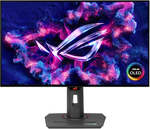Seems a decent deal.
See Monitors unboxed YouTube channel for review.
ASUS ROG Strix XG27AQDMG OLED 240Hz Gaming Monitor $974 + Delivery ($0 C&C/In-Store) @ JB Hi-Fi
Last edited 26/11/2024 - 12:34 by 1 other user
Related Stores
closed Comments

Can confirm, i bought a ROG 240hz monitor and it was great, however, one day i came home and the screen was completely blue. Called support and they said i either needed to buy a new one or throw it out. Was almost exactly 3 months to the day of warranty expiring. Support was cold and unhelpful, they didn't give af

Why are people buying this over the QHD 360Hz Samsung G6 OLED? Can be had sub-$800 if Samsung has stock, but I'd imagine others are going to have deals.
Alienware version is almost at this price too.

Probably because this model comes up as top recommended gaming OLED monitor on review sites like Rtings and Monitor Unboxed.

On what basis? You're not going to get a better experience on a 240Hz WOLED compared to 360Hz QD-OLED.
This is why you don't trust their pseudo-objective scoring system.

Average person who don't know much about OLEDs or monitors in general would look up reviews than buy on a hunch or read the spec sheet and compare 1v1.

@Kevin Bacon: Yeah so a flaw in the ratings system, or an old recommendation list/video. People on this website can just click the category tag and see the value proposition here is mediocre.

@jasswolf: I'm not saying one is better the other. I'm just answering your question of "Why people buy A over B?"
If multiple reviews rate model A as "Recommended" and B is out of stock, people will just flock to buy A.
@Kevin Bacon: I mean I listed two models, one is in stock. Both are absolutely better. One is $200 cheaper, the other is $30 cheaper direct from Dell.
This is a crap deal.

@Kevin Bacon: The Samsung G6, stock permitting. Sticker price goes to $999 on the Samsung AU website, but it's $100 trade-in for any monitor that turns on, 10% loyalty discount from contacting Samsung support chat and quoting a valid Samsung serial number, and 5% for first time app users, which all combine to take it to $768. Deals have been posted a few times.
Sometimes the trade-in jumps to $200, and the loyalty discount hits 15%.

@jasswolf: It’s not 100% the same though
With the G6 you’re giving up a glossy screen that can be used in light environments without turning grey
You’re also getting a much dimmer HDR experience (400 nits vs 750 nits at a 10% window)

@cille745: It's not a thick matte coating, but if you want glossy then get the Alienware. The G6's coating actually diminishes the tint change, which is why it was chosen.
In real world content, the brightness difference is 65 nits, and aside from the 10% window behaviour in testing the Asus is mostly measured 10-15% brighter, but your eyes do not perceive that brightness shift in a linear way, lessening the effect. In fact, longer term, the dynamic range will likely be controlled to keep all values at or under 1000 nits difference in any given environment as your retina only ever perceives a 1000 nit delta, so as this technology scales up (to minimise eye strain from pupil dilation and maximise power efficiency and lifespan of the panel).
So it's brighter, but it's not a dramatic perceptual difference, and you've given up reaching for an extra 50% in refresh rate and 10% rec.2020 colour gamut and volume on a panel technology that takes full advantage of both and offers a more dramatic difference.
Combine that with Samsung's superior burn-in mitigation tech from 2nd gen onwards, and you're making a questionable decision.

@jasswolf: Wouldn’t want the Alienware as you’re buying the screen for pure blacks and you don’t get that unless you’re room is pitch back with the AW (I used to have one)
I understand the way brightness is perceived but I don’t think you’re numbers are right - the RTINGS comparison tells a very different story
Real Scene - 334 vs 253 - 40% more
10% window - 760 vs 470 - 60% moreGiven OLED is barely bright enough as is, I’d rather go for something that’s comfortably enough I’d think, but that’s just my experience after owning them all

@cille745: RTings real scene HDR data between this WOLED implementation and the G6 was ~500 nits vs ~440 nits. You seem to be quoting SDR figures, which are likely clamped on most devices to prevent users from maxing out the panel for no reason (you're not going to want to go over 160-200 nits in a well-lit room for an SDR presentation).
In fact, RTings own test data on SDR brightness confirms they are disabling a feature which maintains equal brightness to deliver those numbers, so at that point it's pseudo-HDR. Enabling the feature lowers the difference to 20 nits.
Wouldn’t want the Alienware as you’re buying the screen for pure blacks and you don’t get that unless you’re room is pitch back with the AW (I used to have one)
In terms of the behaviour of an OLED without a polariser, I never stated otherwise, but none of these are some black obelisk, they all jump significantly above pure black in a light-filled room and grabbing an LCD to deliver better full panel brightness values delivers even greater issues with black uniformity.
I don't know what magic device you're looking for that replaces a cinema screen in a well-lit room, they all have compromises that will require some incredible bright panels and pretty clever compensatory techniques.

Just following up with an available 360Hz OLED deal, $30 cheaper than this: https://www.ozbargain.com.au/node/878574

I decided not to buy this model because it's got a glossy screen and I use it mostly in a bright room during the day. I wouldn't buy a QD-OLED because of the purple tint.
I don't play games like Fortnite or other FPS that benefit from high frame rates, mostly single player open world games. At 1440P I'm assuming you need some pimped out hardware to get anywhere close to 360Hz or even 240Hz?
I've got a 3060ti and a 12600K, I have a PG27AQDM on order to replace my ailing 144Hz LCD which is about 8 years old. I can achieve 144Hz in some games consistently but I think I'll struggle to push the new monitor to 240Hz with recent open world games on my hardware.
What's the point of having a 360 or 480 Hz monitor if you haven't got the hardware to drive it?
P.S. IDK why OZB thinks I'm associated with JB HIFI, I'm not!

Hz is refresh rate, you're referring to FPS. There's plenty of games where you can push past 240, and that number will increase over the lifespan of a monitor as you upgrade your GPU.
eSports titles see the most benefit, sure, and you can manage that easily today on 3060 Ti via DLSS or lowered settings, but you want fluidity on pretty much everything that isn't meant to be a cinematic presentation, and definitely for VR.
I'd imagine you'll bite on the 50 series refresh or a 60 series card, which will deliver this kind of performance handily in most games with a few tweaks and through updated forms of frame generation.
I decided not to buy this model because it's got a glossy screen and I use it mostly in a bright room during the day. I wouldn't buy a QD-OLED because of the purple tint.
Then you should have looked at the G6, which reduces this effect. When actually watching content on the screen in a lit room, it merely slightly warms the image with near-black colours looking a tiny bit more gray, it doesn't make it purple.
P.S. IDK why OZB thinks I'm associated with JB HIFI, I'm not!
You've flagged yourself as associated from the drop down box when you've made your comment, should be able to remove it.

Thanks for the info, it's difficult to get straight answers on how FPS and HZ relate to each other. My understanding is you'll never get higher FPS than the Hz of the monitor, i.e. I can't get more than 144 at the moment. What's worried me is this talk of VRR flicker when the frame rate varies frequently, my thought was if you had a refresh rate that was way above what the PC could keep up with you might get greater fluctuations as it "bursts".
I only use the monitor for gaming and light web browsing, separate dual 28 x 4K's for work and i don't watch any movies etc. on it, I have a TV for that.
I am planning to get something like a 5070ti depending on price…and only if it's a bargain of course ;)
Won't let me remove the association, weird.

My understanding is you'll never get higher FPS than the Hz of the monitor, i.e. I can't get more than 144 at the moment.
That's not accurate, but some games may force you to select a frame cap, and may offer a maximum of your display refresh rate, but this is rare and is usually a programming solve for some maths quirk in the game (usually physics or animations). Where you can push past that point, you do gain input lag benefits (useful for competitive gaming).
What's worried me is this talk of VRR flicker when the frame rate varies frequently, my thought was if you had a refresh rate that was way above what the PC could keep up with you might get greater fluctuations as it "bursts".
VRR may serve to cap frame rate as well, so you might want to disable it once you're past a minimum frame rate. VRR flicker tends to only occur at very low frame rates, and varies from various off-the-shelf implementations. With NVIDIA GSync about to become far more affordable, this is a short-term problem overall.
Won't let me remove the association, weird.
https://www.ozbargain.com.au/wiki/help:faq_beginner#how_do_i…

@jasswolf: Interesting, I'm basing this off an FPS counter displayed by the NVidia software, which never goes above 144.

xg27ucg is at $699

That’s LCD IPS though.

4k ips vs 2k Oled and cheaper price with dual mode.
I would go for it though I use samsung 32 G8.


No instore options available? Delivery by Jan 15 2025 it says. Also seems to be a lot of firmware issues. I nearly pulled the plug but decided against it. That, and ASUS are just terrible for warranty stuff at this point in time.
https://www.google.com/search?q=XG27AQDMG+issues+site:www.re…